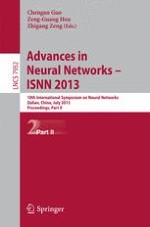The two-volume set LNCS 7951 and 7952 constitutes the refereed proceedings of the 10th International Symposium on Neural Networks, ISNN 2013, held in Dalian, China, in July 2013. The 157 revised full papers presented were carefully reviewed and selected from numerous submissions. The papers are organized in following topics: computational neuroscience, cognitive science, neural network models, learning algorithms, stability and convergence analysis, kernel methods, large margin methods and SVM, optimization algorithms, varational methods, control, robotics, bioinformatics and biomedical engineering, brain-like systems and brain-computer interfaces, data mining and knowledge discovery and other applications of neural networks.
